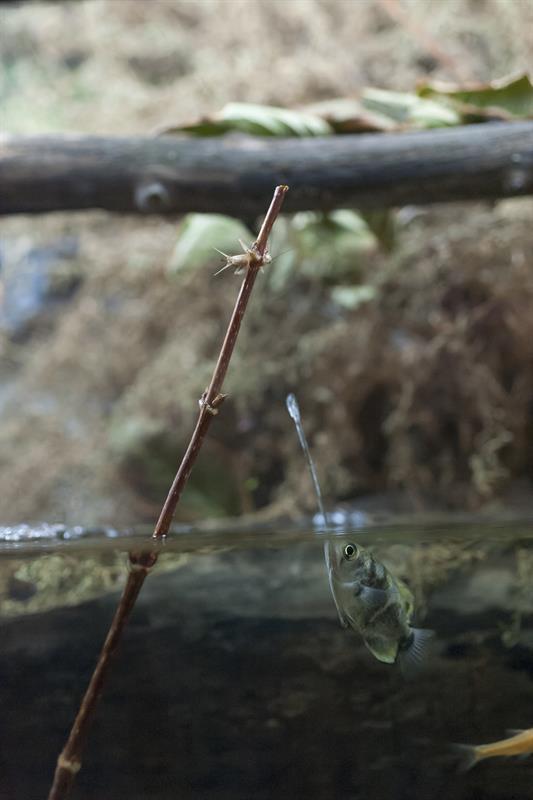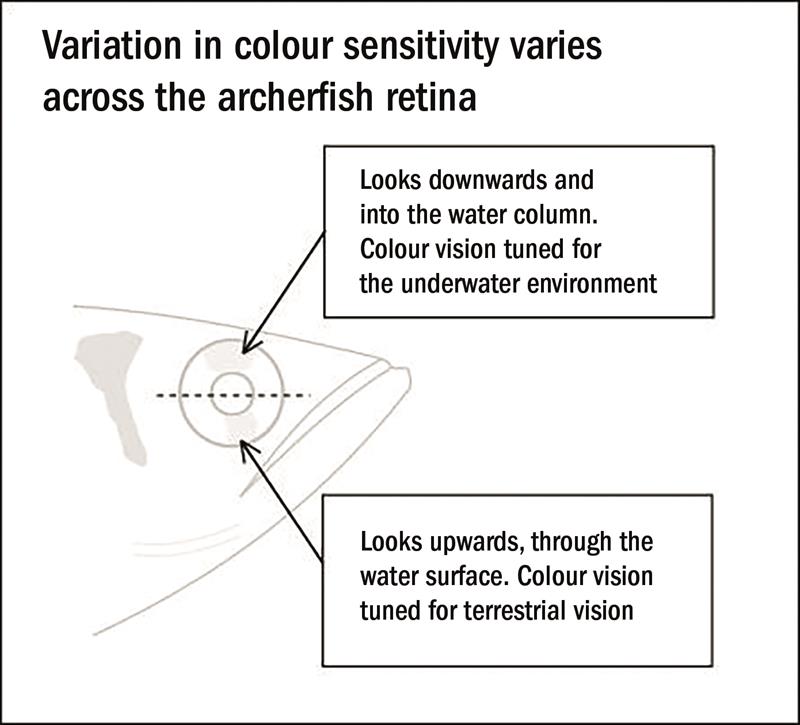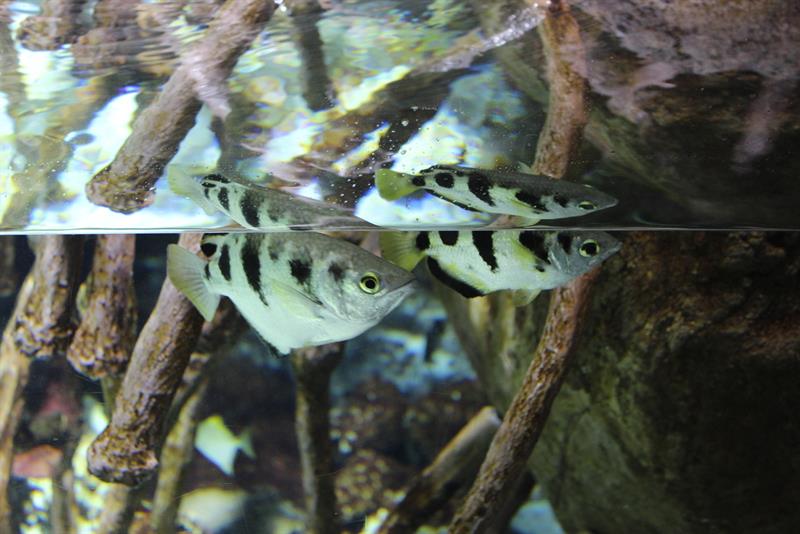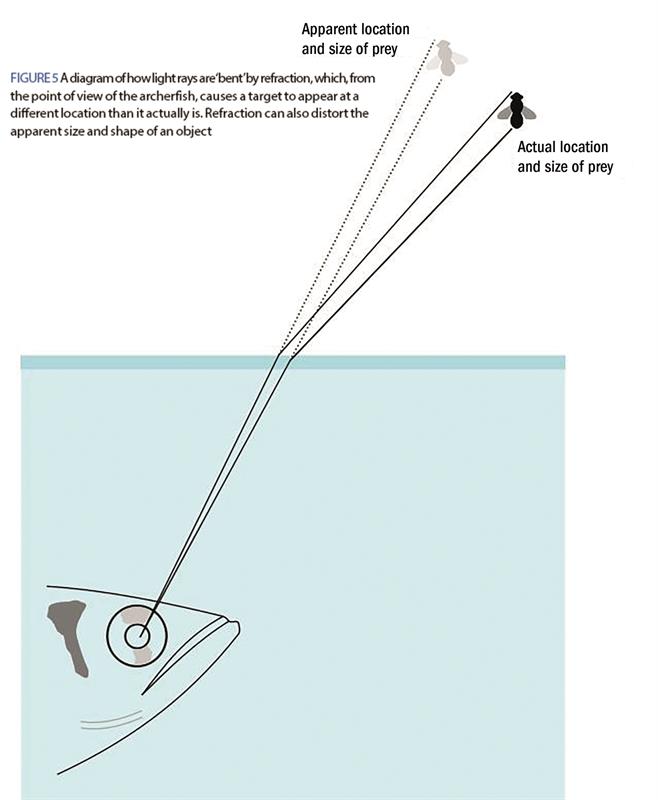
In the tidal waters of tropical mangrove swamps lurks an unassuming little fish. It is about 25cm long, silvery in colour with several black bands across its back. It is an omnivore, eating floating plant matter as well as crustaceans and other small fish. But there is far more to this fish than meets the eye, and the clue is in its name; the archerfish.
Archerfish have a rare talent, if ‘talent’ is the right word for having the ability to shoot a directed jet of water up to two metres into the air. They can use these jets to knock flying insects out of the air or off of their perches and onto the water surface, where they are quickly snapped up by the hungry archerfish. Their jets are also effective underwater, stunning small invertebrates long enough for them to be picked off by the archerfish as an easy meal. Water or air, nowhere it seems, is safe from a hungry archerfish.
The secret to the archerfish’s jet-spitting lies with special adaptations to their mouth and tongue. There is a deep groove that runs along the top of the roof of the mouth and a corresponding hard ridge along the tongue that fits into that groove, which effectively forms the barrel of the archerfish’s water gun. When it is ready to fire, the archerfish takes a large gulp of water and closes its gill covers, building up the pressure within the mouth. Once its weapon is primed, it can fire by opening its mouth a very small amount, releasing the jet of water up to two metres into the air. They can change the dynamics of the jet by altering the shape of their mouth.
While there is some complexity in the formation of these water jets, it is nothing compared to the sophistication of the visual system required to support the archerfish’s hunting strategy. In order to successfully capture prey, the archerfish must first detect it, then accurately determine its position relative to its own, identify what type of target it is and finally capture it from the water surface before another hungry fish gets to it first.
Predatory visual skills

Let us take each of these visual tasks step by step, beginning with the obvious first step of detection. Archerfish prey on small insects that are either in flight or perched close to the surface of the water. They tend to be brown, black or grey in colour, making them difficult to spot against the cluttered background of the mangrove trees. Archerfish also target small aquatic crustaceans, which are well camouflaged to be inconspicuous in the sediment-filled water around their roots. So the archerfish needs to have a visual system that is sensitive to small changes in colour and brightness in both the terrestrial and underwater environments, which are spectrally very different. But that is not an issue for the archerfish; instead of uniform colour vision across the whole of its visual field, it has evolved two different types of colour vision. The cones in the bottom portion of the eye, which look upwards, are spectrally tuned to the spectrum of light that dominate the terrestrial world above the waterline. The cones of the top portion of the eye, which look downwards, are tuned to the colours that dominate the underwater environment. In this way, both halves of the archerfish eye are ideally suited for the task of spotting and identifying their camouflaged prey in front of the cluttered environments of the underwater and above-water worlds.
Once it has spotted its target, the archerfish next needs to determine exactly where it is so that it can accurately direct its water jet and either successfully stun it or knock it into the water. Distance perception is a difficult task for any animal (see my previous articles on depth perception and binocularity), but is made even more complex for the archerfish when targeting insects above the water due to the distortion caused by the refraction of light at the water’s surface.
Figure 3: Archerfish have dual-colour vision. The part of the eye that looks upwards and out of the water is tuned to the colours of the terrestrial, while the part of the eye that looks downwards is specialised for the colours of the aquatic world

When light passes from one medium to another, it alters direction due to a change in the speed of light. Light only travels at light speed in a vacuum. It travels slower when passing through a dense medium such as water or glass than it does in air. As any optician will of course know, this phenomenon of light ‘bending’ as it passes through glass is the foundation of how corrective lenses work. The problem for the archerfish is that, due to refraction, the insect will appear to them to be at a different location than it really is, similar to how a swimming pool looks shallower than it actually is (see figures 4 and 5). Refraction will also cause the insect to look smaller and possibly distort its shape. To add even more complexity, the extent of these distorting effects are not constant, but vary depending on the position of the fish relative to its prey. So, the archerfish needs an equally complex solution.
Figure 4: A photo of a pair of archerfish taken with a semi-submerged lens show the distorting effects of the refraction of light that occurs at the surface of the water

Correcting distortions
Initially it was thought that, having identified the approximate location of their prey, the archerfish would position themselves directly underneath it to minimise the distortion as refractive effects are exaggerated by viewing angle. However, close observation revealed that they take up a wide range of positions, with a viewing angle ranging from 45 degrees to 110 degrees relative to the water surface. Additionally, they will alter their position in between shooting water jets at their target (not every shot meets its target), even when they are targeting stationary prey that remains in the same position. So, rather than trying to actively minimise the distortion, archerfish must have some way of correcting for it. They also use jets underwater, where refraction is not an issue, so they must have the ability to ‘turn off’ this correction, else they would be constantly missing aquatic prey.
How they correct (or not, when appropriate) for refraction, however, is currently a mystery. It is possible that this ability is just instinctual, or it could be acquired through learning. There is anecdotal evidence that archerfish who observe other archerfish hunting have a more accurate strike themselves. Interestingly, once they have the ‘knack’, they do not need to practice to maintain their accuracy when targeting stationary prey. However, when it comes to moving targets, it seems as though they do need to practice to keep their skills sharp.
So having spotted their target and worked out where it is, accounting for the distortions of refraction, next the archerfish needs to produce a jet of water that will successfully disable its prey. Crucially, it needs to produce the right type of jet appropriate to its target as the dynamics of an insect in flight are quite different from those of one that is stationary or a crustacean swimming through the water column. When it comes to shooting down or stunning prey, one size does not fit all. Amazingly, archerfish are able to ‘craft’ their water jet by precisely controlling the variations in the way they open their mouth to release the jet. They can change the shape of the jet and its range.
There is a final complication: the archerfish must be able to get to its stricken prey before another fish gets to it first. Therefore, it must ensure that its prey hits the water (or is stunned) at a distance close enough for the archerfish to reach it in time. They do this by carefully selecting their position relative to the target, and also by varying the speed of their water jet. If they are far away from the target, they use a slower jet than if they were closer to the target so as to give themselves enough time to swim to the anticipated ‘drop zone’. So not only are archerfish masters of fluid dynamics, but they are also able to solve the complex visual and cognitive problems of detection, location and identification.
Eyes literally as big as the stomach

Archerfish have no visual cortex in their brains. Instead, it seems as though the processing required to solve the complex visual tasks that they face happens earlier on in the neural pathway. Instead of thinking with the brain, archerfish think with their eyes. In fact, each single eye is about twice the size of their brain (and coincidentally larger than their stomachs – so for the archerfish, the old saying is right; their eyes really are bigger than their stomachs). So how does the neural underpinning of this fantastic fishy visual system compare to our own? Is it possible that the archerfish see the world similarly to ourselves?
As for humans, the visual pathway of the archerfish begins with the retina. They have an area of high acuity, though it is not technically speaking a fovea. Rather it is called the area centralis. Like a fovea, it is a region of increased density retinal ganglion cells giving very high acuity. This is the part of the eye that is mainly used during prey capture. Their acuity, 0.15 degrees, is higher than most fish and many birds. So, as you would expect from a fish with such a complex hunting strategy, they see the world around them in clear, sharp detail. However, the downside of this high acuity is that they can only see clearly in bright light, limiting the time they are able to hunt.
The similarities between the brains of archerfish and humans does not stop there. The area in the archerfish brain responsible for processing the visual information relayed from signals from the retina, is called the optic tectum. This region contains cells with three categories of visual receptive field: those tuned to particular orientations, particular directions and some that are direction ‘agnostic’, meaning they are sensitive to visual movement in any directions. The optic tectum is approximately homologous to the superior colliculus region of the mammalian brain, which is, in part, responsible for object detection, edge detection and colour processing. Consequently, it is very likely that the optic tectum is responsible for similar visual processes in archerfish.
If this is the case (and it certainly appears to be so), despite large differences in the brain structures of archerfish and mammals, visual functions are strikingly similar, despite the actual neural processing happening in completely different parts of the brain. This is quite astonishing. Nature, resourceful as ever, has found more than one solution to the problem of how animals can see the world around them.
So far from being an unassuming little fish, the archerfish is a quite extraordinary animal capable of incredible feats of fluid dynamics, which are made possible by a sophisticated visual system that is very similar and yet very different from our own.
